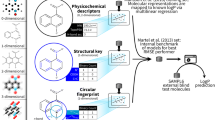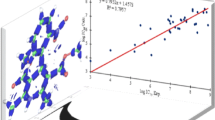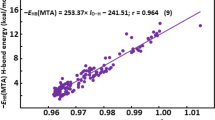Abstract
We report new 3D fragment descriptors to model parameters and properties of stereoisomeric molecules and conformers. New 3D fragment descriptors have been applied to discriminate between stereoisomers in predictive QSPR modeling of the standard free energy (∆G°) for the 1:1 inclusion complexation of 76 chiral guests with β-cyclodextrin (β-CD) and 40 chiral guests with 6-amino-6-deoxy-β-cyclodextrin (am-β-CD) in water at 298 K. The in-house software, mfSpace (Molecular Fragments Space), was used for QSPR modeling, generation and coding of the 3D fragment descriptors. The program implements the Singular Value Decomposition for Multiple Linear Regression analysis as machine learning method. We used ensemble modeling techniques which include the generation of many individual models, the selection of the most relevant ones and followed by their joint application to test compounds, i.e., applying a consensus model for average predictions. The models based on 2D and 3D fragment descriptors provide the best predictions in external fivefold cross-validation: root mean squared error RMSE = 1.1 kJ/mol and determination coefficient \(R_{{det}}^{2}\) = 0.918 (β-CD), RMSE = 0.89 kJ/mol and \(R_{{det}}^{2}\) = 0.910 (am-β-CD).








Similar content being viewed by others
References
Douhal, A. (ed.): Cyclodextrin Materials. Photochemistry, Photophysics and Photobiology. Elsevier, Amsterdam (2006)
Dodziuk, H. (ed.): Cyclodextrins and Their Complexes. Chemistry, Analytical Methods, Applications. Wiley-VCH, Weinheim (2006)
Jin, Z.-Y.: Cyclodextrin Chemistry. Preparation and Application. World Scientific, Singapore (2013)
Klein, C.T., Polheim, D., Viernstein, H., Wolschann, P.: A method for predicting the free energies of complexation between β-cyclodextrin and guest molecules cyclodextrin chemistry. preparation and application. J. Inclusion Phenom. Macrocycl. Chem. 36, 409–423 (2000)
Solov’ev, V.P., Tsivadze, A.Y.: Supramolecular complexes: determination of stability constants on the basis of various experimental methods. Prot. Metals Phys. Chem. Surf. 51(1), 1–35 (2015)
Matsui, Y., Nishioka, T., Fujita, T.: Biomimetic and Bioorganic Chemistry, pp. 61–89. Springer, Berlin (1985)
Liu, L., Guo, Q.-X.: Wavelet neural network and its application to the inclusion of β-cyclodextrin with benzene derivatives. J. Chem. Inf. Comput. Sci. 39(1), 133–138 (1999)
Suzuki, T., Ishida, M., Fabian, W.M.F.: Classical QSAR and comparative molecular field analyses of the host-guest interaction of organic molecules with cyclodextrins. J. Comput. Aided Mol. Des. 14, 669–678 (2000)
Suzuki, T.: A nonlinear group contribution method for predicting the free energies of inclusion complexation of organic molecules with a- and β-cyclodextrins. J. Chem. Inf. Comput. Sci. 41(5), 1266–1273 (2001)
Bodor, N., Buchwald, P.: Theoretical insights into the formation, structure, and energetics of some cyclodextrin complexes. J. Inclusion Phenom. Macrocycl. Chem. 44, 9–14 (2002)
Faucci, M.T., Melani, F., Mura, P.: Computer-aided molecular modeling techniques for predicting the stability of drug–cyclodextrin inclusion complexes in aqueous solutions. Chem. Phys. Lett. 358, 383–390 (2002)
Katritzky, A.R., Fara, D.C., Yang, H., Karelson, M., Suzuki, T., Solov’ev, V.P., Varnek, A.: Quantitative structure-property relationship modeling of β-cyclodextrin complexation free energies. J. Chem. Inf. Comp. Sci. 44(2), 529–541 (2004)
Steffen, A., Apostolakis, J.: On the ease of predicting the thermodynamic properties of β-cyclodextrin inclusion complexes. Chem. Cent. J. 1(1), 29–39 (2007)
Chari, R., Qureshi, F., Moschera, J., Tarantino, R., Kalonia, D.: Development of improved empirical models for estimating the binding constant of a β-cyclodextrin Inclusion complex. Pharm. Res. 26(1), 161–171 (2009)
Prakasvudhisarn, C., Wolschann, P., Lawtrakul, L.: Predicting complexation thermodynamic parameters of β-cyclodextrin with chiral guests by using swarm intelligence and support vector machines. Int. J. Mol. Sci. 10, 2107–2121 (2009)
Perez-Garrido, A., Helguera, A.M., Cordeiro, M.N.D.S., Escudero, A.G.: QSPR modelling with the topological substructural molecular design approach: β-cyclodextrin complexation. J. Pharm. Sci. 98(12), 4557–4576 (2009)
Connors, K.A.: The stability of cyclodextrin complexes in solution. Chem. Rev. 97(5), 1325–1357 (1997)
Rekharsky, M., Inoue, Y.: Chiral recognition thermodynamics of β-cyclodextrin: the thermodynamic origin of enantioselectivity and the enthalpy-entropy compensation effect. J. Am. Chem. Soc. 122(18), 4418–4435 (2000)
Rekharsky, M.V., Inoue, Y.: Complexation and chiral recognition thermodynamics of 6-Amino-6-deoxy-β-cyclodextrin with anionic, cationic, and neutral chiral guests: counterbalance between van der Waals and Coulombic interactions. J. Am. Chem. Soc. 124(5), 813–826 (2002)
Rekharsky, M.V., Goldberg, R.N., Schwarz, F.P., Tewari, Y.B., Ross, P.D., Yamashoji, Y., Inoue, Y.: Thermodynamic and nuclear magnetic resonance study of the interactions of a- and β-cyclodextrin with model substances: phenethylamine, ephedrines, and related substances. J. Am. Chem. Soc. 117(34), 8830–8840 (1995)
Liu, Y., Yang, E.-C., Yang, Y.-W., Zhang, H.-Y., Fan, Z., Ding, F., Cao, R.: Thermodynamics of the molecular and chiral recognition of cycloalkanols and camphor by modified β-cyclodextrins possessing simple aromatic tethers. J. Org. Chem. 69(1), 173–180 (2004)
Liu, L., Li, W.-G., Guo, Q.-X.: Association constant prediction for the inclusion of α-cyclodextrin with benzene derivatives by an artificial neural network. J. Inclusion Phenom. Macrocycl. Chem. 34, 291–298 (1999)
Loukas, Y.L.: Quantitative structure-binding relationships (QSBR) and artificial neural networks: improved predictions in drug: cyclodextrin inclusion complexes. Int. J. Pharm. 226, 207–211 (2001)
Estrada, E., Perdomo-Lopez, I., Torres-Labandeira, J.J.: Combination of 2D-, 3D-connectivity and quantum chemical descriptors in QSPR. Complexation of a- and β-cyclodextrin with benzene derivatives. J. Chem. Inf. Comput. Sci. 41(6), 1561–1568 (2001)
Jimenez, V., Alderete, J.B.: The role of charge transfer interactions in the inclusion complexation of anionic guests with a-cyclodextrin. Tetrahedron 61, 5449–5456 (2005)
Ghasemi, J.B., Salahinejad, M., Rofouei, M.K., Mousazadeh, M.H.: Docking and 3D-QSAR study of stability constants of benzene derivatives as environmental pollutants with a-cyclodextrin. J. Incl. Phenom. Macrocycl. Chem. 73, 405–413 (2012)
Klein, C.T., Polheim, D., Viernstein, H., Wolschann, P.: Predicting the free energies of complexation between cyclodextrins and guest molecules: linear versus nonlinear models. Pharm. Res. 17(3), 358–365 (2000)
Buchwald, P.: Complexation thermodynamics of cyclodextrins in the framework of a molecular size-based model for nonassociative organic liquids that includes a modified hydration-shell hydrogen-bond model for water. J. Phys. Chem. B 106(27), 6864–6870 (2002)
Ghasemi, J.B., Salahinejad, M., Rofouei, M.K.: An alignment independent 3D-QSAR study for predicting the stability constants of structurally diverse compounds with β-cyclodextrin. J. Incl. Phenom. Macrocycl. Chem. 71, 195–206 (2011)
Merzlikine, A., Abramov, Y.A., Kowsz, S.J., Thomas, V.H., Mano, T.: Development of machine learning models of β-cyclodextrin and sulfobutylether-β-cyclodextrin complexation free energies. Int. J. Pharm. 418, 207–216 (2011)
Sang, P., Zou, J.-W., Dai, D.-M., Hu, G.-X., Jiang, Y.-J.: Prediction of the complexation of structurally diverse compounds with β-cyclodextrin using structural descriptors derived from electrostatic potentials on molecular surface and different chemometric methods. Chemom. Intell. Lab. Syst. 127, 166–176 (2013)
Veselinović, A.M., Veselinović, J.B., Toropov, A.A., Toropova, A.P., Nikolić, G.M.: In silico prediction of the β-cyclodextrin complexation based on Monte Carlo method. Int. J. Pharm. 495(1), 404–409 (2015)
Todeschini, R., Consonni, V.: Handbook of Molecular Descriptors. Wiley-VCH, Weinheim (2000)
Varnek, A.: Fragment descriptors in structure-property modeling and virtual screening. In: Bajorath, J. (ed.) Chemoinformatics and Computational Chemical Biology, pp. 213–243. Springer, New York (2011)
Baskin, I., Varnek, A.: Fragment descriptors in SAR/QSAR/QSPR studies, molecular similarity analysis and in virtual screening. In: Varnek, A., Tropsha, A. (eds.) Chemoinformatics Approaches to Virtual Screening, pp. 1–43. RCS Publishing, Cambridge (2008)
Solov’ev, V.P., Varnek, A.A., Wipff, G.: Modeling of ion complexation and extraction using substructural molecular fragments. J. Chem. Inf. Comput. Sci. 40(3), 847–858 (2000)
Varnek, A., Solov’ev, V.P.: “In Silico” design of potential anti-HIV actives using fragment descriptors. Comb. Chem. High Throughput Screen. 8(5), 403–416 (2005)
Katritzky, A.R., Kuanar, M., Slavov, S., Dobchev, D.A., Fara, D.C., Karelson, M., Acree, W.E.J., Solov’ev, V.P., Varnek, A.: Correlation of blood–brain penetration using structural descriptors. Bioorg. Med. Chem. 14(14), 4888–4917 (2006)
Varnek, A., Kireeva, N., Tetko, I.V., Baskin, I.I., Solov’ev, V.P.: Exhaustive QSPR studies of a large diverse set of ionic liquids: how accurately can we predict melting points? J. Chem. Inf. Model. 47(3), 1111–1122 (2007)
Varnek, A., Solov’ev, V.: Quantitative structure-property relationships in solvent extraction and complexation of metals. In: Sengupta, A.K., Moyer, B.A. (eds.) Ion Exchange and Solvent Extraction, A Series of Advances, pp. 319–358. CRC Press, Taylor and Francis Group, Boca Raton (2009)
Solov’ev, V., Oprisiu, I., Marcou, G., Varnek, A.: Quantitative structure–property relationship (QSPR) modeling of normal boiling point temperature and composition of binary azeotropes. Ind. Eng. Chem. Res. 50(24), 14162–14167 (2011)
Solov’ev, V., Kireeva, N., Ovchinnikova, S., Tsivadze, A.: The complexation of metal ions with various organic ligands in water: prediction of stability constants by QSPR ensemble modelling. J. Incl. Phenom. Macrocycl. Chem. 83, 89–101 (2015)
Glavatskikh, M., Madzhidov, T., Solov’ev, V., Marcou, G., Horvath, D., Graton, J., Le Questel, J.-Y., Varnek, A.: Predictive models for halogen-bond basicity of binding sites of polyfunctional molecules. Mol. Inf. 35(2), 70–80 (2016)
Glavatskikh, M., Madzhidov, T., Solov’ev, V., Marcou, G., Horvath, D., Varnek, A.: Predictive models for the free energy of hydrogen bonded complexes with single and cooperative hydrogen bonds. Mol. Inf. 35(11–12), 629–638 (2016)
Varnek, A., Fourches, D., Horvath, D., Klimchuk, O., Gaudin, C., Vayer, P., Solov’ev, V., Hoonakker, F., Tetko, I.V., Marcou, G.: ISIDA—Platform for virtual screening based on fragment and pharmacophoric descriptors. Curr. Comput. Aided Drug Des. 4(3), 191–198 (2008)
Solov’ev, V., Sukhno, I., Buzko, V., Polushin, A., Marcou, G., Tsivadze, A., Varnek, A.: Stability constants of complexes of Zn2+, Cd2+, and Hg2+ with organic ligands: QSPR consensus modeling and design of new metal binders. J. Inclusion Phenom. Macrocycl. Chem. 72(3–4), 309–321 (2012)
Muller, P.H., Neumann, P., Storm, R.: Tafeln der mathematischen Statistik. VEB Fachbuchverlag, Leipzip (1979)
Solov’ev, V.P., Varnek, A.A.: EdChemS (Editor of Chemical Structures). http://vpsolovev.ru/programs/ (2008–2017). Accessed 18 Jan 2017
Solov’ev, V.P., Varnek, A.A.: EdiSDF (Editor of Structure—Data Files). http://vpsolovev.ru/programs/ (2008–2017). Accessed 18 Jan 2017
Varnek, A., Fourches, D., Hoonakker, F., Solov’ev, V.P.: Substructural fragments: an universal language to encode reactions, molecular and supramolecular structures. J. Comput. Aid. Mol. Des. 19(9–10), 693–703 (2005)
HyperChem. http://www.hyper.com (2017). Accessed 18 Jan 2017
Blondel, A., Karplus, M.: New formulation for derivatives of torsion angles and improper torsion angles in molecular mechanics: elimination of singularities. J. Comput. Chem. 17(9), 1132–1141 (1996)
Mathematics. How do I calculate a dihedral angle given Cartesian coordinates? http://math.stackexchange.com/questions/47059/how-do-i-calculate-a-dihedral-angle-given-cartesian-coordinates (2016). Accessed 27 Aug 2016
The Cambridge Structure Database. http://www.ccdc.cam.ac.uk (2016). Accessed 9 Sept 2016
Ou, G.C., Li, Z.Z., Zhang, M., Yuan, X.Y.: Chiral resolution of L- and D-alanine and a racemic macrocyclic nickel(II) complex: synthesis and crystal structures. Transit. Met. Chem. 39, 135–140 (2014)
Solov’ev, V.P., Kireeva, N., Tsivadze, A.Y., Varnek, A.: QSPR ensemble modelling of alkaline-earth metal complexation. J. Incl. Phenom. Macrocycl. Chem. 76(1–2), 159–171 (2013)
Zhokhova, N.I., Baskin, I.I., Palyulin, V.A., Zefirov, A.N., Zefirov, N.S.: Fragmental descriptors with labeled atoms and their application in QSAR/QSPR studies. Dokl. Chem. 417(2), 282–284 (2007)
Kubinyi, H.: Variable selection in QSAR studies. II. A highly efficient combination of systematic search and evolution. Quant. Struct. Act. Relat. 13(4), 393–401 (1994)
Ali, M., Pant, M., Abraham, A.: A simplex differential evolution algorithm: development and applications. Trans. Inst. Meas. Control. 34(6), 691–704 (2011)
Mohamed, A.W., Sabry, H.Z., Khorshid, M.: An alternative differential evolution algorithm for global optimization. Adv. Res. 3, 149–165 (2012)
Wang, Y., Chen, X., Gui, W., Yang, C., Caccetta, L., Xu, H.: A hybrid multiobjective differential evolution algorithm and its application to the optimization of grinding and classification. J. Appl. Math. 2013, 1–15 (2013)
Dalby, A., Nourse, J.G., Hounshell, W.D., Gushurst, A.K.I., Grier, D.L., Leland, B.A., Laufer, J.: Description of several chemical structure file formats used by computer programs developed at Molecular Design Limited. J. Chem. Inf. Comput. Sci. 32(3), 244–255 (1992)
Hedderich, J., Sachs, L.: Angewandte Statistik. Methodensammlung mit R. Springer, Berlin (2016)
Acknowledgements
A.S. gratefully acknowledges Dr. Rimma Akhmetsafina and Dr. Rodriges Zalipynis R.A. for providing useful suggestions for improving software quality.
Author information
Authors and Affiliations
Corresponding author
Electronic supplementary material
Below is the link to the electronic supplementary material.
10847_2017_739_MOESM1_ESM.sdf
Supplementary material 1 (SDF 108 KB)—Structure data files b-CD_76.SDF and am-b-CD_40.SDF contain the optimized 3D structures of 76 and 40 chiral guests and experimentally estimated standard free energies for the 1:1 inclusion complexation with β-cyclodextrin (β-CD) and 6-amino-6-deoxy-β-cyclodextrin (am-β-CD) in water at 298.15 K.
Rights and permissions
About this article
Cite this article
Solovev, A., Solov’ev, V. 3D molecular fragment descriptors for structure–property modeling: predicting the free energies for the complexation between antipodal guests and β-cyclodextrins. J Incl Phenom Macrocycl Chem 89, 167–175 (2017). https://doi.org/10.1007/s10847-017-0739-z
Received:
Accepted:
Published:
Issue Date:
DOI: https://doi.org/10.1007/s10847-017-0739-z




